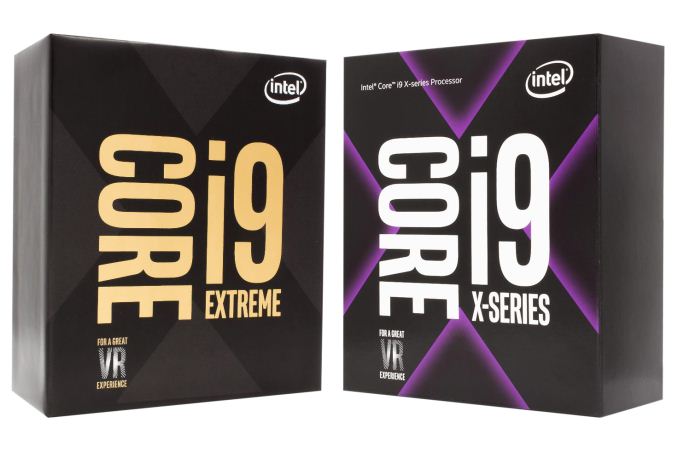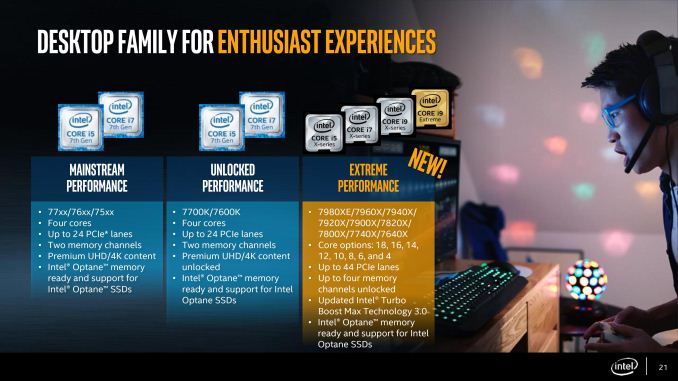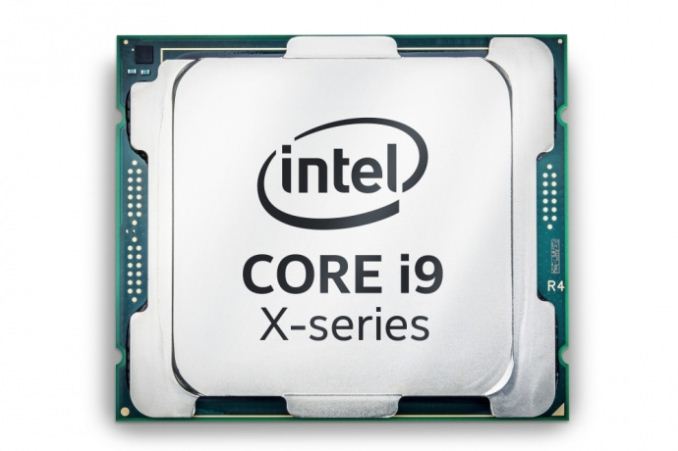Intel Announces Skylake-X: Bringing 18-Core HCC Silicon to Consumers for $1999
by Ian Cutress on May 30, 2017 3:03 AM EST
There are days in this profession in which I am surprised. The longer I stay in the technology industry, they become further and further apart. There are several reasons to be surprised: someone comes out of the blue with a revolutionary product and the ecosystem/infrastructure to back it up, or a company goes above and beyond a recent mediocre pace to take on the incumbents (with or without significant financial backing). One reason is confusion, as to why such a product would ever be thought of, and another is seeing how one company reacts to another.
We’ve been expecting the next high-end desktop version of Skylake for almost 18 months now, and fully expected it to be an iterative update over Broadwell-E: a couple more cores, a few more dollars, a new socket, and done. Intel has surprised us with at least two of the reasons above: Skylake-X will increase the core count of Intel’s HEDT platform from 10 to 18.
The Skylake-X announcement is a lot to unpack, and there are several elements to the equation. Let’s start with familiar territory: the first half of the processor launch.
Announcement One: Low Core Count Skylake-X Processors
The last generation, Broadwell-E, offered four processors: two six-core parts, an eight-core part, and a top-tier 10-core processor. The main difference between the two six-core parts was the PCIe lane count, and aside from the hike in pricing for the top-end SKU, these were iterative updates over Haswell-E: two more cores for the top processor.
This strategy from Intel is derived from what they call internally as their ‘LCC’ core, standing for ‘low core count’. The enterprise line from Intel has three designs for their silicon – a low core count, a high core count, and an extreme core count: LCC, HCC, and XCC respectively. All the processors in the enterprise line are typically made from these three silicon maps: a 10-core LCC silicon die, for example, can have two cores disabled to be an 8-core. Or a 22-core XCC die can have all but four cores disabled, but still retain access to all the L3 cache, to have an XCC processor that has a massive cache structure. For the consumer HEDT platform, such as Haswell-E and Broadwell-E, the processors made public were all derived from the LCC silicon.
The first half of the Skylake-X processor llineup follows this trend. Intel will launch four Skylake-X processors based on the LCC die, which for this platform will have a maximum of 12 cores. All processors will have hyperthreading.
| Skylake-X Processors (Low Core Count Chips) | ||||
| Core i7-7800X | Core i7-7820X | Core i9-7900X | Core i9-7920X | |
| Cores/ Threads |
6/12 | 8/16 | 10/20 | 12/24 |
| Base Clock | 3.5 GHz | 3.6 GHz | 3.3 GHz | TBD |
| Turbo Clock | 4.0 GHz | 4.3 GHz | 4.3 GHz | TBD |
| TurboMax Clock | N/A | 4.5 GHz | 4.5 GHz | TBD |
| L3 | 8.25 MB | 11 MB | 13.75 MB | TBD (Likely 13.75 MB) |
| PCIe Lanes | 28 | 44 | TBD (Likely 44) |
|
| Memory Channels | 4 | |||
| Memory Freq | DDR4-2400 | DDR4-2666 | TBD | |
| TDP | 140W | TBD | ||
| Price | $389 | $599 | $999 | $1199 |
The bottom processor is the Core i7-7800X, running at 3.5 GHz with a 4.0 GHz turbo. This design will not feature Intel’s new ‘favored core’ Turbo 3.0 technology (more on that below), but will have six cores, support quad-channel memory at DDR4-2400, come in at a TDP of 140W, have 28 PCIe lanes, and retail for around $400. This processor will be the entry level model, for any user who needs the benefit of quad-channel memory but perhaps doesn’t need a two-digit number of cores or has a more limited budget.
Next up is the Core i7-7820X, which hits a potential sweet spot in the LCC design. This is an eight-core processor, with the highest LCC base clock of 3.6 GHz and the joint-highest turbo settings: 4.3 GHz for regular turbo and 4.5 GHz for favored core. Unlike the previous processor, this CPU gets support for DDR4-2666 memory.
However in another break from Intel’s regular strategy, this CPU will only support 28 PCIe lanes. Normally only the lowest CPU of the HEDT stack would be adjusted in this way, but Intel is using the PCIe lane allocation as another differentiator as a user considers which processor in the stack to go for. This CPU also runs in at 140W, and comes in at $600. At this price, we would expect it to be competing directly against AMD’s Ryzen 7 1800X, which will be the equivalent of a generation behind in IPC but $100 cheaper.
| Comparison: Core i7-7820X vs. Ryzen 7 1800X | ||
| Intel Core i7-7820X |
Features | AMD Ryzen 7 1800X |
| 8 / 16 | Cores/Threads | 8 / 16 |
| 3.6 / 4.3GHz (4.5 GHz TMax) |
Base/Turbo | 3.6 / 4.0 GHz |
| 28 | PCIe 3.0 Lanes | 16 |
| 11 MB | L3 Cache | 16 MB |
| 140 W | TDP | 95 W |
| $599 | Price (MSRP) | $499 |
The third processor is also a change for Intel. Here is the first processor bearing the new Core i9 family. Previously we had Core i3, i5 and i7 for several generations. This time out, Intel deems it necessary to add another layer of differentiation in the naming, so the Core i9 naming scheme was the obvious choice. If we look at what the Core i9 name brings to the table, the obvious improvement is PCIe lanes: Core i7 processors will have 28 PCIe lanes, while Core i9 processors will have 44 PCIe lanes. This makes configuring an X299 motherboard a little difficult: see our piece on X299 to read up on why.
Right now the Core i9-7900X is the only Core i9 with any details: this is a ten core processor, running with a 3.3 GHz base, a 4.3 GHz turbo and a 4.5 GHz favored core. Like the last processor, it will support DDR4-2666 and has a TDP of 140W. At this level, Intel is now going to charge $100/core, so this 10-core part runs in at a $999 tray price ($1049 retail likely).
One brain cell to twitch when reading this specification is the price. For Ivy Bridge-E, the top SKU was $999 for six-cores. For Haswell-E, the top SKU was $999 for eight-cores. For Broadwell-E, we expected the top SKU for 10-cores to be $999, but Intel pushed the price up to $1721, due to the way the enterprise processors were priced. For Skylake-X, the new pricing scheme is somewhat scrapped again. This 10-core part is now $999, which is what we expected the Broadwell-E based Core i7-6950X to be. This isn’t the top SKU, but the pricing comes back down to reasonable levels.
Meanwhile for the initial launch of Skylake-X, it is worth noting that this 10-core CPU, the Core i9-7900X, will be the first one available to purch. More on that later.
Still covering the LCC core designs, the final processor in this stack is the Core i9-7920X. This processor will be coming out later in the year, likely during the summer, but it will be a 12-core processor on the same LGA2066 socket for $1199 (retail ~$1279), being part of the $100/core mantra. We are told that Intel is still validating the frequencies of this CPU to find a good balance of performance and power, although we understand that it might be 165W rather than 140W, as Intel’s pre-briefing explained that the whole X299 motherboard set should be ready to support 165W processors.
In the enterprise space, or at least in previous generations, Intel has always had that processor that consumed more power than the rest. This was usually called the ‘workstation’ processor, designed to be in a single or dual socket design but with a pumped up frequency and price to match. In order for Intel to provide this 12-core processor to customers, as the top end of the LCC silicon, it has to be performant, power efficient, and come in at reasonable yields. There’s a chance that not all the factors are in place yet, especially if they come out with a 12-core part that is clocked high and could potentially absorb some of their enterprise sales.
Given the expected timing and launch for this processor, as mentioned we were expecting mid-summer, that would have normally put the crosshairs into Intel’s annual IDF conference in mid-August, although that conference has now been canned. There are a few gaming events around that time to which Intel may decide to align the launch to.












203 Comments
View All Comments
Alexvrb - Tuesday, June 6, 2017 - link
[In the near future:]Oh man, they just released a board with THREE M.2 slots! My old board with only TWO (one populated) is now old and outdated!
Iketh - Wednesday, June 7, 2017 - link
You're all technologically ignorant. JKflipflop is most correct here because even tho what ddriver says is true, the cpu must still be designed and traced to work with an existing pin array instead of creating the cpu with a pin array that is efficient to the new cpu architecture. It's not the motherboard anymore, it's the signaling and power routing inside the cpu that matters most.In other words, if JKflip had said "Why would you EVER buy a brand new CPU, then immediately castrate its performance across the board by forcing it to route power and signaling in a way that doesn't jive with it's architecture?" he would have been correct.
theuglyman0war - Thursday, June 8, 2017 - link
Still on x58 with an i7 980x and to be honest I just keep upgrading my gpu's and resent incremental cpu advancement. It is actually the chipset loss that keeps my eyes wandering to ddr4 pci 3.0 lanes and nvme not to mention my horrible sata 3 speeds on my rog III rampage ex which are hard to get around and not feel ghetto despite the pascal ti sli.:(
Them chipset features sure do add up after a while.
sharath.naik - Thursday, June 8, 2017 - link
JKflipflop, Iketh you both are brainwashed. If you are not go head and explain how much more you need to pay for boot raid options with x299?(Or you did not know you will have to pay up to 300$ more to unlock features of x299 motherboard)? if you did not know this, then yes brainwashed is the only word that can be used for you two.LithiumFirefly - Friday, June 9, 2017 - link
What completely baffles me is why an Intel fanboy would defend buying a new Intel high-end desktop line after the last one, x99. The X99 PCH I bought only had six chips made for it, four of them are bonkers price and the other two are gimped. The Broadwell-e update was a joke the older Haswell chips overclocked way better so they were faster than the newer stuff yeah I'm definitely going to try the new Intel stuff after that. /smelgross - Thursday, June 1, 2017 - link
You can't just double the core count. Where are they going to put those cores? I assume that the silicon isn't just sitting there waiting for them.mickulty - Saturday, June 3, 2017 - link
All of AMD's high-end CPUs are based on the same 8-core die, "zeppelin". Ryzen is one zeppelin, threadripper is two connected by infinity fabric on a multi-chip module, naples is four again connected by infinity fabric on a MCM. AMD could very easily put out a chip with more zeppelins, although maintaining socket compatibility would mean losing some i/o capability.Interestingly this means Ryzen has 32 PCIe lanes on the chip but only 16 are actually available on AM4. Presumably this is something to do with Bristol Ridge and Raven Ridge AM4 compatibility since they have less lanes.
theuglyman0war - Thursday, June 8, 2017 - link
why not? just make the socket bigger and increase my utility bill ( or at least give me the option to suffer power if I wanna )Supposedly processing power is only limited by the size of the universe theoretically. :)
theuglyman0war - Thursday, June 8, 2017 - link
isn't silicon just sand?ddriver - Tuesday, May 30, 2017 - link
AMD will not and doesn't need to launch anything other than 16 core. Intel is simply playing the core count game, much like it played the Mhz game back in the days of pentium4. More cores must be better.But at that core count you are already limited by thermal design. So if you have more cores, they will be clocked lower. So it kind of defeats the purpose.
More cores would be beneficial for servers, where the chips are clocked significantly lower, around 2.5 Ghz, allowing to hit the best power/performance ratio by running defacto underclocked cores.
But that won't do much good in a HEDT scenario. And AMD does appear to have a slight IPC/watt advantage. Not to mention offering significantly better value due to better price/performance ratio.
So even if intel were to launch an 18 core design, that's just a desperate "we got two more cores" that will do little to impress potential customers for that market niche. It will be underclocked and expensive, and even if manages to take tangible lead against a 16 core threadripper, it will not be worth the money.